The Tyan Transport SX TS65A-B8036 is an AMD EPYC 7002 “Rome” series 2U server with a lot to offer. It utilizes a single AMD EPYC 7002 series socket and then extends functionality for memory, storage, and expansion to make it a platform capable of competing with dual Intel Xeon Scalable systems. In our review, we are going to take a look at the key features of the system along with how it performs.
Tyan Transport SX TS65A-B8036 Overview
As we have done with many of our recent reviews, we are going to split our Tyan Transport SX TS65A-B8036 overview into two parts. First, we are going to look at the exterior of the chassis. We will then transition to see what is inside.
Tyan Transport SX TS65A-B8036 External Overview
The front of the 2U chassis is new for this generation. Instead of using a 24-bay front panel design, Tyan’s engineers now have 26x front hot-swap bays increasing front panel storage density by 8.3%.
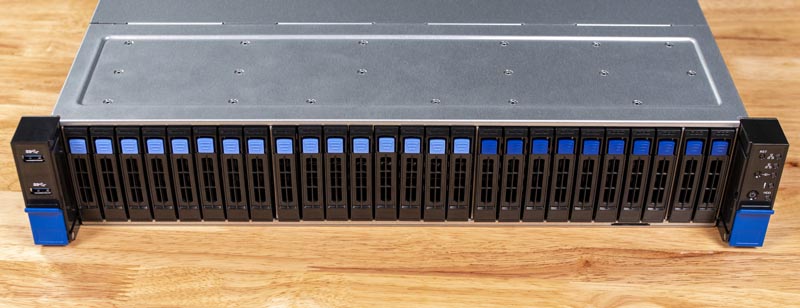
The lighter blue tab drives are the 16x 2.5″ U.2 NVMe drive bays. All of these U.2 drives are cabled directly to the motherboard and the CPU which means that they do not require a PCIe switch even for 64 lanes of PCIe that underpin this design. That lowers BOM cost and power consumption while increasing performance for the Tyan Transport SX TS65A-B8036.
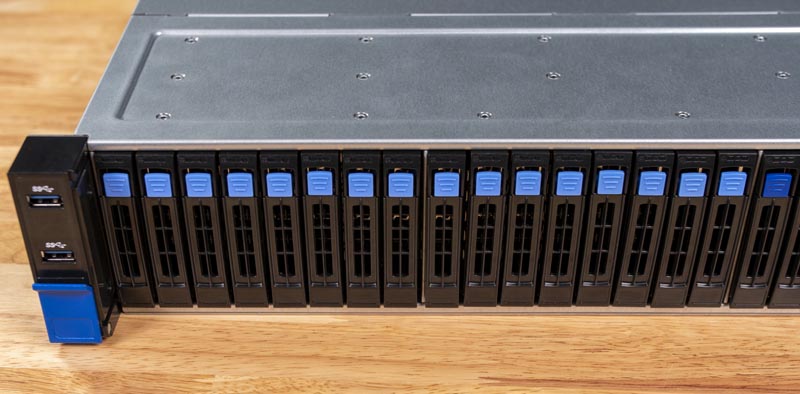
On the right side, there are ten more drive bays. These are for 2.5″ SATA storage (SAS with appropriate controllers.) That adds a lower performance storage tier to the chassis, but this is not for OS drives. Instead, these ten drives are for a storage array.
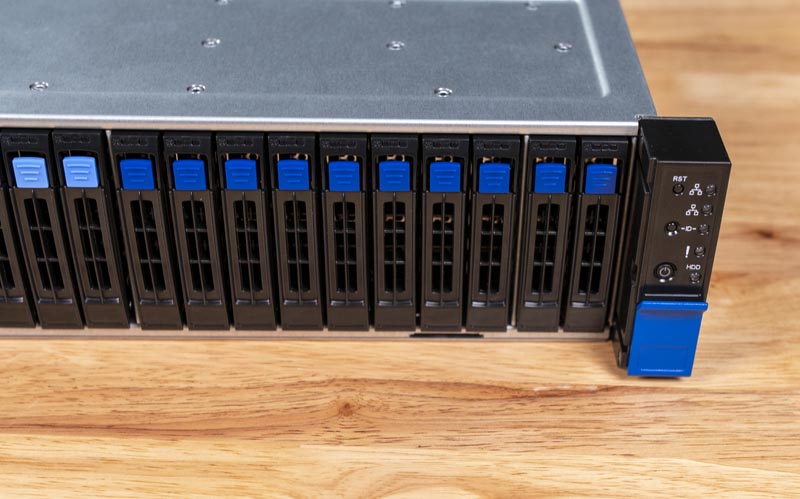
One can see that the way Tyan’s engineers made 26x front hot-swap bays possible was by moving the two USB 3.0 ports, power and reset buttons, as well as LED indicators to the rack ear overhangs. Another great feature of these drive trays is that they are tool-less. One no longer needs to use screws to install each drive. That saves 104 screw installations on just the front 2.5″ trays for each system.
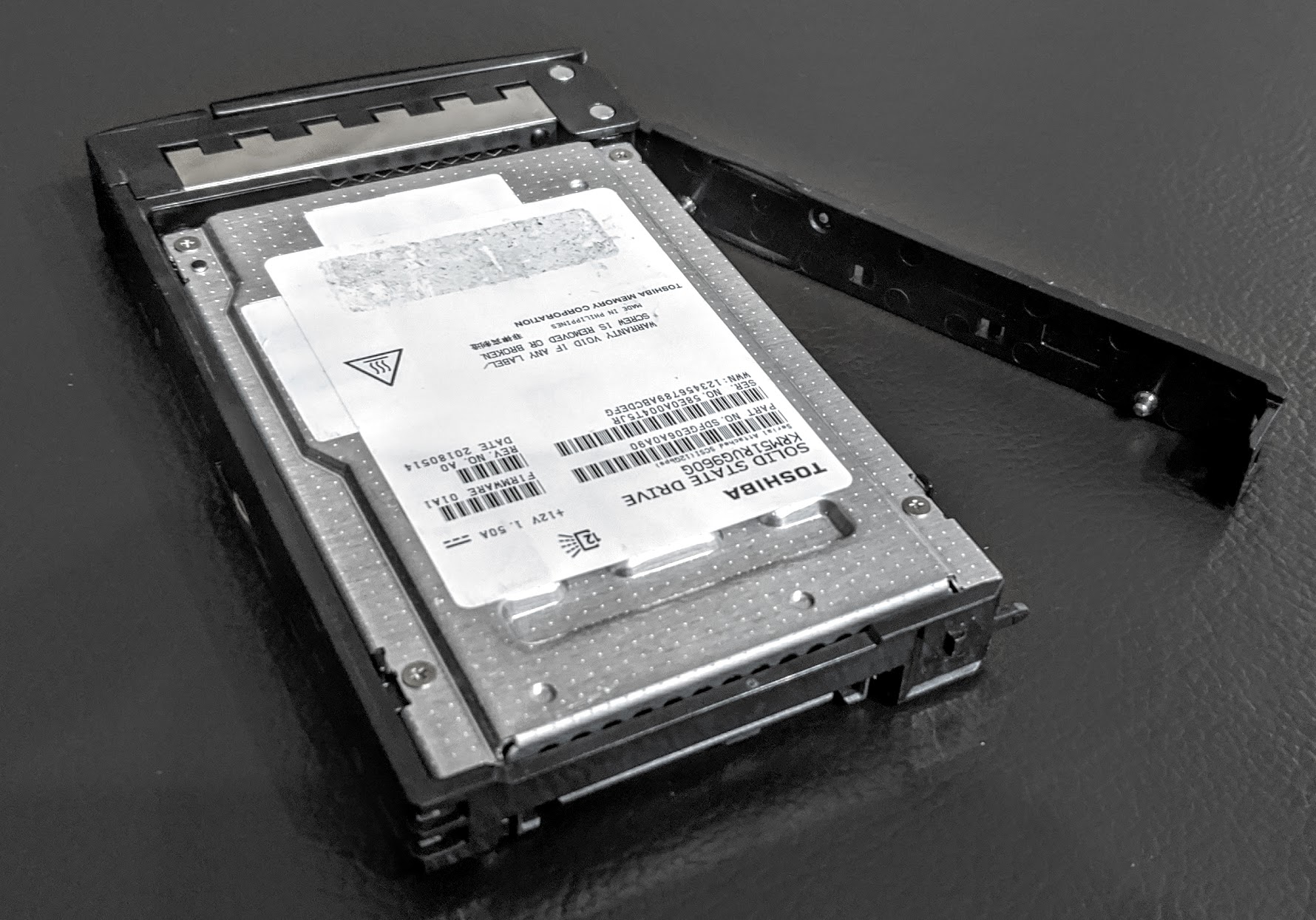
Powering this storage is a flexible backplane system on the Tyan Transport SX TS65A-B8036. The backplanes can be swapped out using thumb screws which makes servicing significantly faster than with previous designs. This is a great serviceability feature.
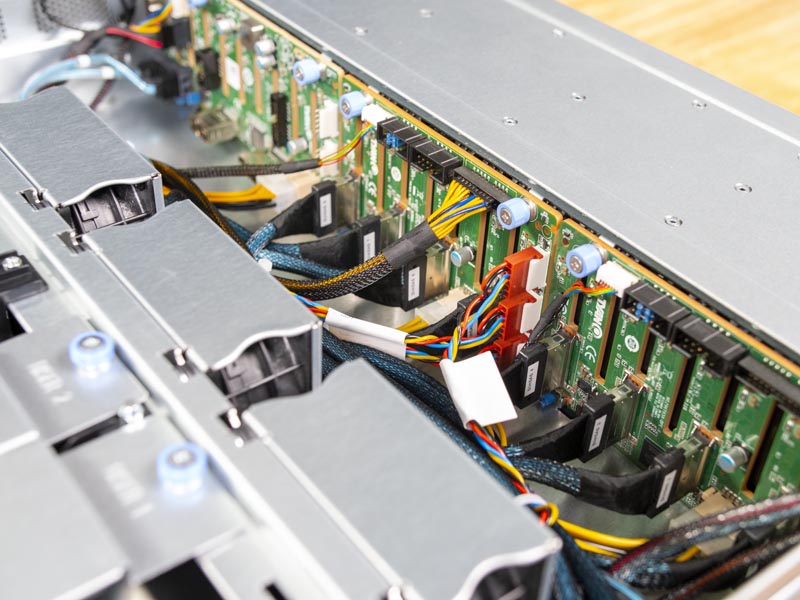
Moving to the rear of the chassis, one can see a fairly complete rear I/O layout, especially for a single-socket server. On the left, there are two 1.2kW 80Plus Titanium power supplies for redundancy. This is a great job by the Tyan staff to use high-efficiency power supplies which will lower power consumption thereby furthering a commitment to the environment.
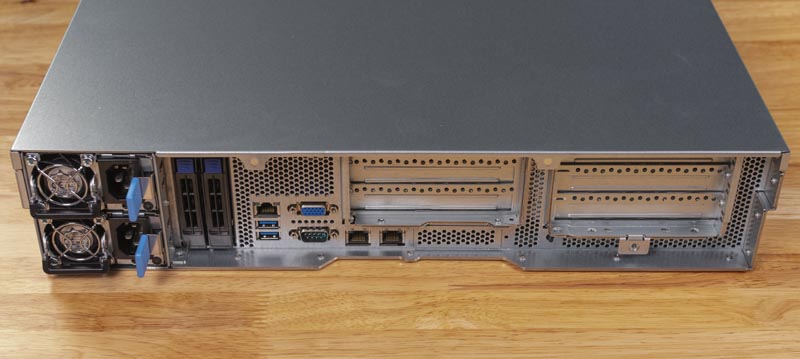
On the right side, one can see an array of six PCIe slots mounted horizontally. Later in this review, we will show the risers that power those expansion slots.
Moving to the rear I/O panel, one can see the two rear 2.5″ SATA bays. These bays are designed to be utilized with low-cost 2.5″ SATA SSDs for OS drive installation. This means that technically the Tyan Transport SX TS65A-B8036 is a 28x 2.5″ hot-swap bay design.
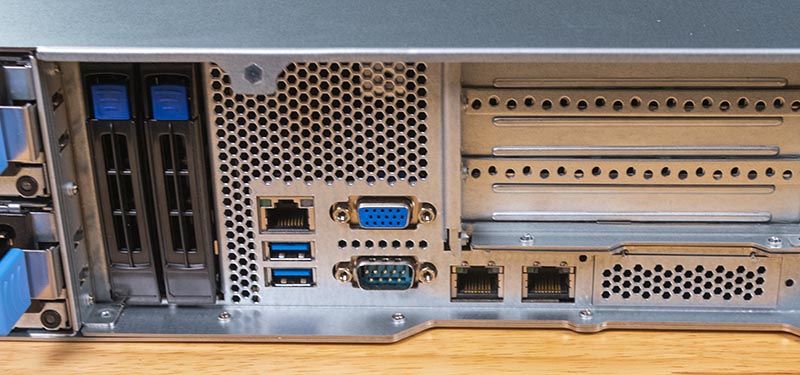
One can find a basic server rear I/O layout with a management port, two USB 3.0 ports, a VGA port and a serial console port on the rear. The two 1GbE NICs are powered by a Broadcom BCM5720 chipset. These are not meant for primary networking duties. Instead, there is an OCP 2.0 network slot for OCP mezzanine cards such as dual 25GbE adapters. One also can use the PCIe Gen4 expansion slots for 100GbE and 200GbE connectivity in this platform.
Tyan Transport SX TS65A-B8036 Internal Overview
Inside the Tyan Transport SX TS65A-B8036 we have a layout we have seen before from the company. Behind the front 2.5″ drive backplanes is a set of three fans that cool the CPU and expansion cards. Expansion cards are placed on a centerline riser system.
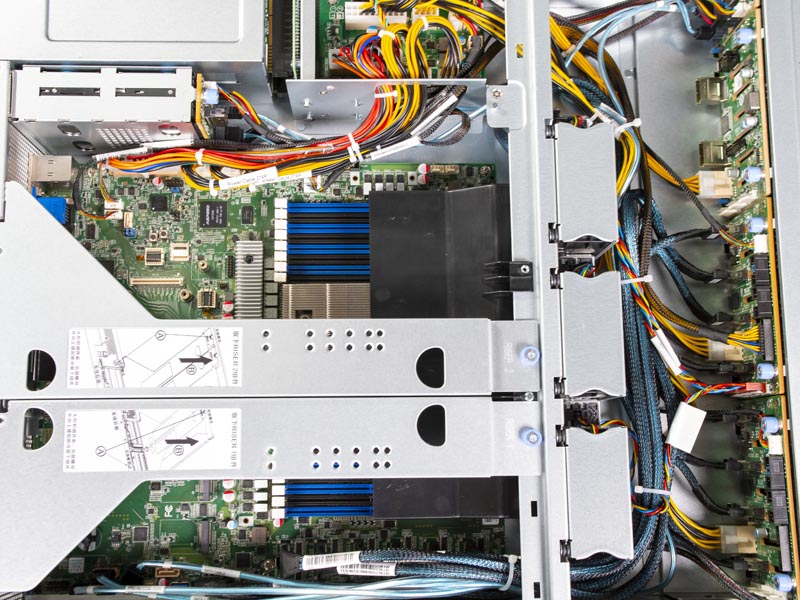
Showing the risers in this configuration is relatively challenging. This is the best shot we got. You can see there are a total of six PCIe Gen4 slots. Four are PCIe x8 while two are PCIe x16 in size. Since these are PCIe x24 risers, one cannot get a full 32 PCIe lanes that would be required to run all electrically at 2×8 + 1×16 configurations. One of the slots is muxed with the OCP mezzanine slot’s B connection. These risers are easy to remove. Our test unit operates more smoothly than the previous generation, but they are not at the same ease of service one would expect from a PowerEdge or ProLiant server.
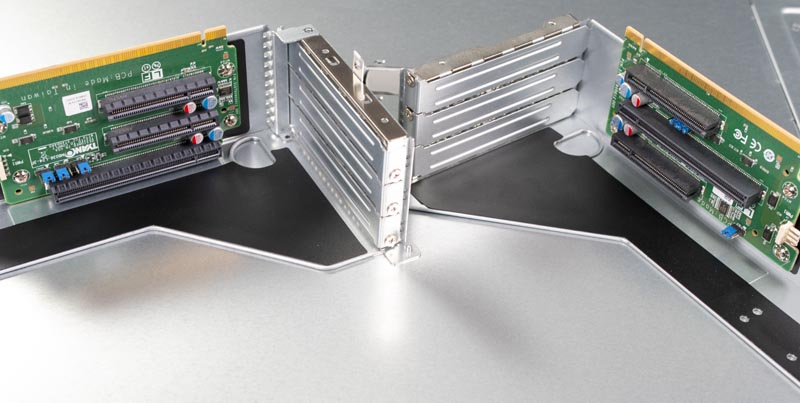
The CPU socket accepts a single AMD EPYC CPU up to 225W. That means you can run the AMD EPYC 7742 at its default TDP. We still suggest that the EPYC 7702P is a better fit for this server given its price/ performance ratio and slightly lower TDP.
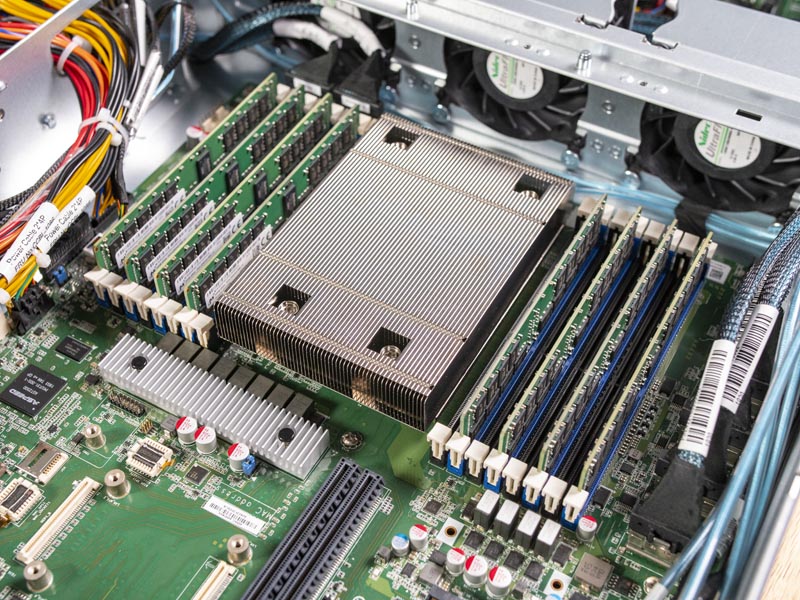
One will also see that there is a full set of 16x DDR4 DIMMs. We have 8x 32GB Micron DDR4-3200 RDIMMs installed here but one can go up to 4TB of RAM in this platform using 16x 256GB DIMMs.
Beyond the PCIe risers, there is an OCP 2.0 mezzanine slot. This is still a PCIe Gen3 technology as we will see the next generation OCP 3.0 NICs utilize PCIe Gen4. Still, this is perfect for solutions such as dual 25GbE adapters.
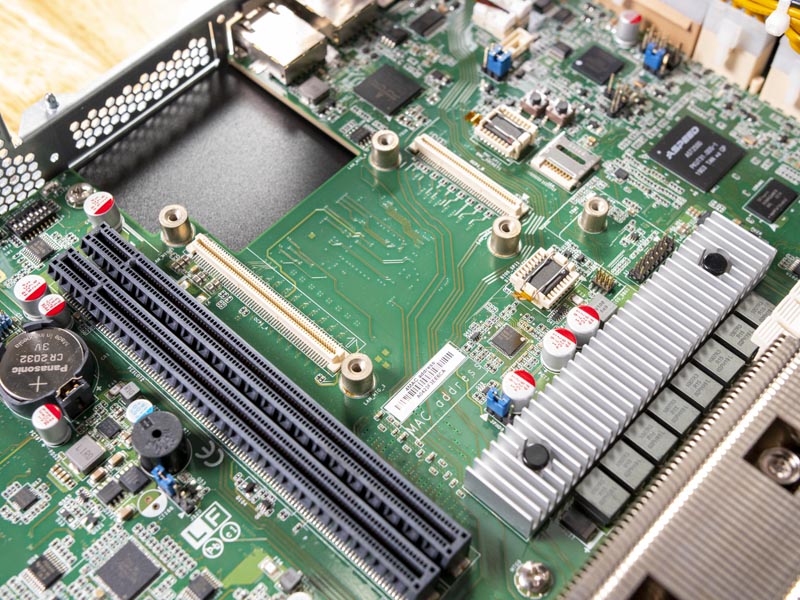
Also on the motherboard one can find two M.2 slots for boot SSDs. Tyan is supporting M.2 2280 (80mm) as well as M.2 22110 (110mm) here which is great. Using M.2 22110 allows one to use drives like the Intel Optane DC P4801X Review 100GB M.2 NVMe SSD for a log device without using the front 2.5″ U.2 drive bays. With the dual SATA rear 2.5″ bays, there are plenty of boot options available.
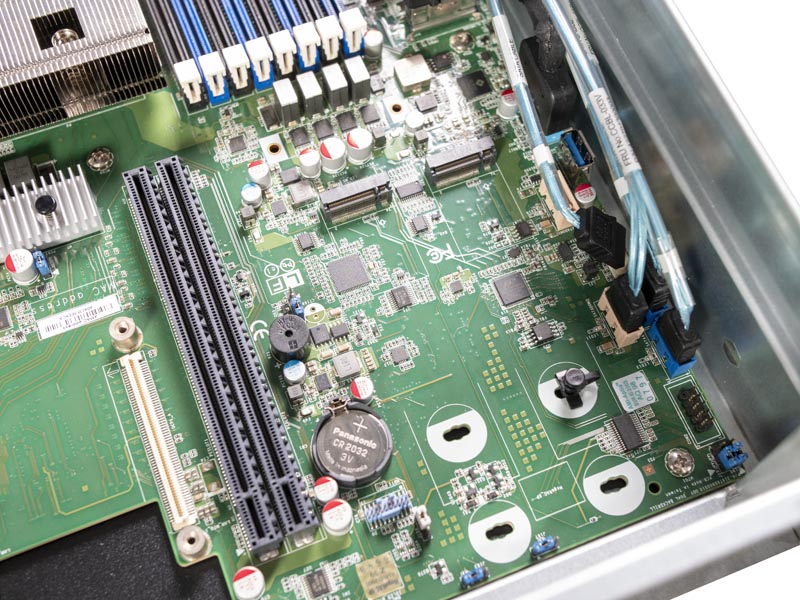
One can see another innovation that Tyan made here. The M.2 drive mounting points are tool-less. Instead of the older generation with hard mounting points and tiny screws, Tyan now has an easy to configure mounting solution. We like this attention to detail.
Next, we are going to look at the topology, management, and test configuration before we move to our performance testing.

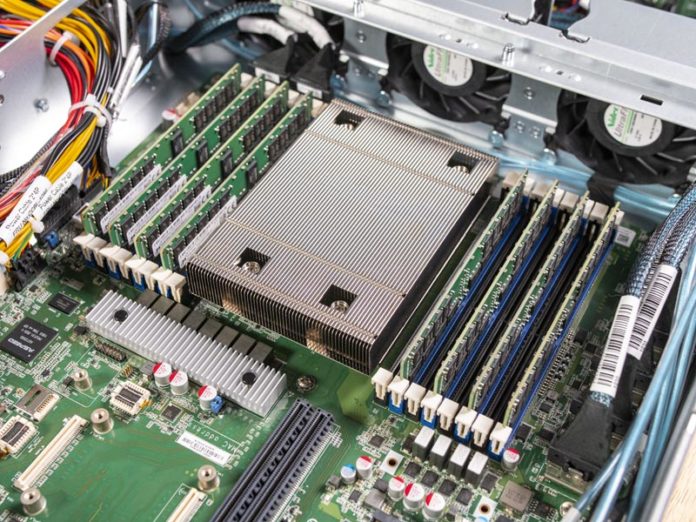



1- You forgot to mention that there is a with 28x SATA model
2- I don’t agree with your assessment of the capacity storage ranking of the unit. It could support more that 170TB+ of storage using 24x 7.36TB SATA and NVMe drives. I don’t know of many places which need more than that (if they do they have other problems ;-])
3- It is unfortunate that Tyan “cheaped” out on onboard NICs, they could have used 2x 10Gbe-T instead of the legacy 1Gbe-T ports
4- Finally, it is unfortunate that Tyan doesn’t bother with getting Windows certification for their servers, this system would be ideal for a Windows 2019 Storage Spaces Direct solution I am currently designing/planning.
I agree with you on point 2, running 3-6 of these chassis populated out and you can have a lot of commodity flash for your backend. Even running vSAN would probably perform pretty well.
On point 3, meh. Do you really need it since you can run the dual 25g which is adequate for most storage/replication workloads and then you can run a mcx516a if you need more throughput
4. People still use Windows for storage? I’m curious about your environment now.
We can always request R&D to process Windows certification if we see further inquiries like yours
Yay! Finally!
Tyan has, by far, the best AMD EPYC Rome story going today.
I was beginning to wonder if STH was biased towards Gigabyte. ;)
@Rob D, yes please. We have plans for the entire Tyan AMD EPYC Rome line with regards to Azure Stack HCI certification (Fred S. is our Tyan contact).
@Philip E,
I would be thrilled for Tyan to offer servers with Azure Stack HCI certification!
But I would be very happy just for the “basic” Windows 2019 (+ SDDC Premium) certification given that the Windows Server Catalog only has 1 Tyan server system listed (period) with only 2008R2 certification ;-(.
@BinkyTo Working on it. :)